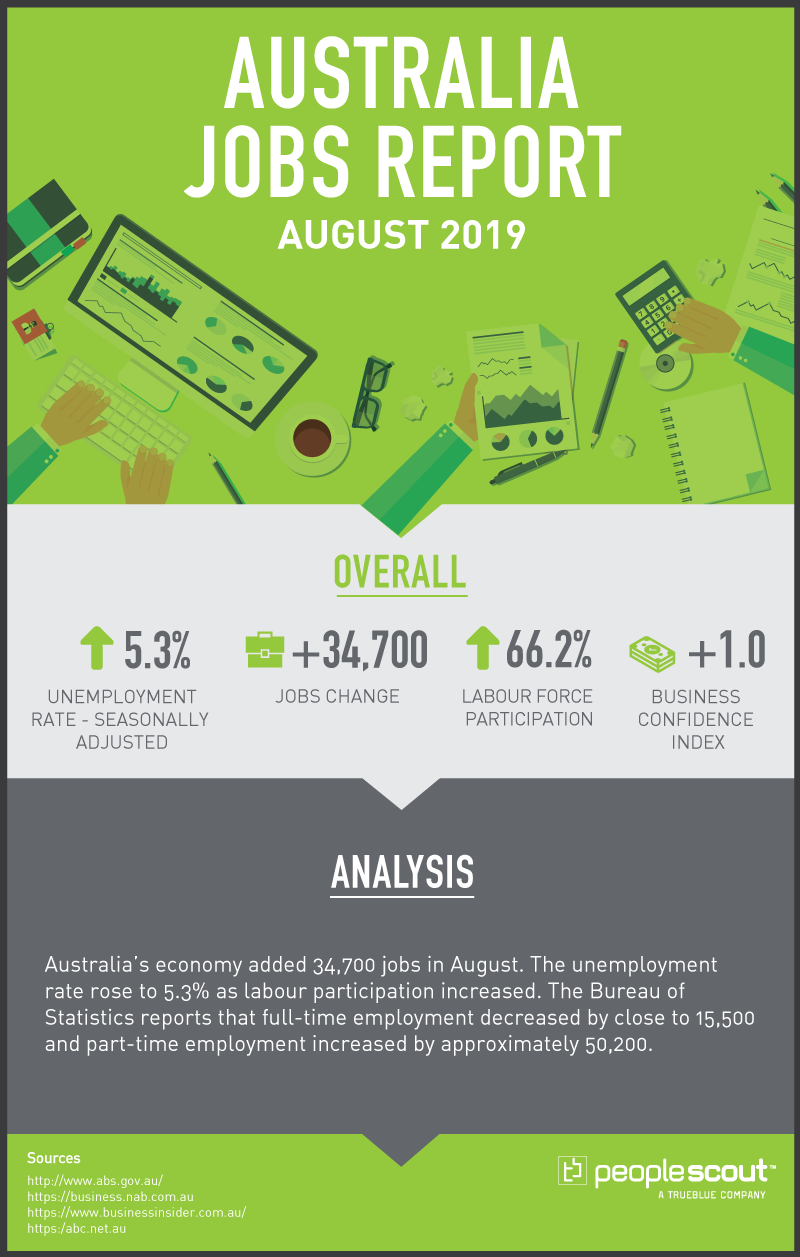Australia’s economy added 34,700 jobs in August. The unemployment rate rose to 5.3% as labour participation increased. The Bureau of Statistics reports that full-time employment decreased by close to 15,500 and part-time employment increased by approximately 50,200.

Numbers
34,700: The Australian economy added 34,700 jobs in August.
5.3%: The Australian unemployment rate rose to 5.3%.
66.2%: Labour force participation rose to 66.2%.
+1: The Business Confidence Index fell to +1 in the latest NAB release.
Upside
The Australian economy added 34,700 jobs in August, beating analyst expectations of just 15,000. While the unemployment rate increased, this was due in part to the growing number of Australians that are either working or looking for work. The labour force participation rose to 66.2%, a record high.
In seasonally adjusted terms, the largest increases in employment were in Victoria, up 20,300 and New South Wales with an increase of 16,700. Since August 2018, full-time employment has increased by 186,700 persons, and part-time employment has increased by 124,000.
Downside
This year-long trend of full-time job growth outpacing part-time employment did not hold in August. Close to 15,500 full-time jobs were eliminated in August with this decrease offset by an increase of approximately 50,200 part-time positions. This growing participation rate boosted the unemployment number to a 12 month high. Unemployment rates spiked in South Australia, where it rose from 6.9% to 7.3%, and Tasmania, where it increased from 6% to 6.4%.
The underutilisation rate, which includes those who are both unemployed and underemployed (needing additional work) also rose to 13.8%. The number of available workers is growing faster than the number of jobs, especially full-time jobs. Much of the increase in the nation’s labour force is due to strong population growth figures fueled by immigration. The most recent quarterly ABS data shows Australia’s population grew by 389,000, or 1.6% year leading to March 2019, which includes a 250,000 rise in net overseas migration.
This weakness in the job market is bad news for those hoping to see wage increases in the near future as BIS Oxford economist Sean Langcake explained:
“While employment growth has been reasonably healthy over the past year, the demand for labour is being met with increased supply. This is working to keep a lid on wages growth.”
Job Growth in the Service Sector
In the last year, which sectors have driven the “reasonably healthy” growth? A recent article by Jason Murphy notes that Australia is transforming into a service economy. A service economy is one that runs primarily on services provided rather than on goods produced. This can be viewed as a net positive for the nation.
Since March 2013, Australia has added over one million jobs in household and business services while losing jobs in manufacturing and mining. Data from ABS (Australian Bureau of Statistics), shows that while manufacturing jobs once paid as well as work at a bank or telecommunications work, this is no longer the case. Compared to manufacturing, there is much more money to be made in the service sector.
While taking a broad view of what constitutes a service job, Murphy argues that the growing service sector is good for the country, which has an aging population and is faced with global trade uncertainty:
“We have this old-fashioned idea that service jobs are burger-flipping, and yes, there’s entry-level jobs like that, but lots of service sector jobs are doctors and nurses, lawyers and consultants.
Those are good jobs in many ways. Safe, well-paid jobs that you can do until late in life. But they are also good because it is much harder for international trade to undermine them. Chinese manufacturing may have caused the demise of a lot of Australian factories, but Chinese hospitals don’t do much to affect Australian hospitals.”




